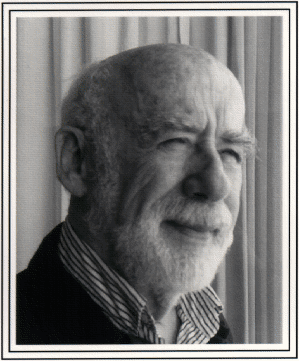
The Author's History
by Egan O'Connor
John William Gofman is Professor Emeritus of Molecular and Cell Biology, University of California at Berkeley, CA 94720-5706. He is also on the faculty at the University of California Medical School at San Francisco (UCSF). His life's work is divisible into three main areas, which converge for the first time in this monograph. Some of the earlier work is cited in the monograph's Reference List.* (1) While a graduate student at U.C. Berkeley, Gofman earned his Ph.D. (1943) in nuclear/physical chemistry, with his dissertation on the discovery of Pa-232, U-232, Pa-233, and U-233, the proof that U-233 is fissionable by slow and fast neutrons, and discovery of the 4n + 1 radioactive series. His faculty advisor was Glenn T. Seaborg (who became Chairman of the Atomic Energy Commission, 1961-1971). Seaborg, Gofman, and Raymond W. Stoughton share Patent #3,123,535 on the slow and fast neutron fissionability of uranium-233, with its application to production of nuclear power or nuclear weapons. The work is recounted in Seaborg's book "Nuclear Milestones" (1972).
Post-doctorally, Gofman continued research related to the first atomic bombs --- particularly the chemistry of plutonium, at a time when the world's total supply was less than 0.25 milligram. He shares patents #2,671,251 and #2,912,302 on two processes for separating plutonium from the uranium and fission products of irradiated nuclear fuel. "We all were pushing the envelope in those years, and in the process, we learned the habit of observing details very closely."
* (2) After the plutonium work, Gofman completed medical school (1946) at UCSF, where the faculty and his classmates selected him to receive the annual Gold-Headed Cane Award for having the qualities of "a true physician."
In 1947, following his internship in Internal Medicine, Gofman joined the faculty at U.C. Berkeley (Division of Medical Physics), where he began his research on lipoproteins and Coronary Heart Disease at the Donner Laboratory. At the time, only two types of blood lipoproteins were known: Alpha and beta. By devising special flotation techniques with the ultracentrifuge, he and Frank T. Lindgren and co-workers at the Donner Lab began to reveal (1949-1950) the great diversity of very-low-density, intermediate-density, low-density, and high-density lipoproteins (VLDL, IDL, LDL, HDL) which truly exist in the bloodstream.
Their work on the chemistry of lipoproteins (e.g., the cholesterol-rich and triglyceride-rich varieties), and on dietary experiments, and on epidemiologic studies, soon produced evidence that high blood levels of the LDL, IDL, and VLDL lipoproteins are a risk-factor for Coronary Heart Disease.
In 1954, Gofman received the Modern Medicine Award for outstanding contributions to heart disease research. In 1965, he received the Lyman Duff Lectureship Award of the American Heart Association, for his research in atherosclerosis and Coronary Heart Disease. In 1972, he shared the Stouffer Prize for outstanding contributions to research in arteriosclerosis. In 1974, the American College of Cardiology selected him as one of twenty-five leading researchers in cardiology of the past quarter-century.
* (3) Meanwhile, in the early 1960s, the Atomic Energy Commission (AEC) asked Gofman to establish a Biomedical Research Division at the AEC's Livermore National Laboratory, for the purpose of evaluating the health effects of all types of nuclear activities. From 1963-1965, Gofman served as the division's first director and concurrently as an Associate Director of the full laboratory. Then he stepped down from the administrative activities in order to have more time for his own laboratory research on Cancer and chromosomes (the Boveri Hypothesis), on radiation-induced chromosomal mutations and genomic instability, and for his analytical work on the epidemiologic data from the Japanese atomic-bomb survivors and other irradiated human populations.
By 1969, Gofman and a Livermore colleague, Dr. Arthur R. Tamplin, had concluded that human exposure to ionizing radiation was much more serious than previously recognized. Because of this finding, Gofman and Tamplin spoke out publicly against two AEC programs which they had previously accepted. One was Project Plowshare, a program to explode hundreds or thousands of underground nuclear bombs in the Rocky Mountains in order to liberate (radioactive) natural gas, and to use nuclear explosives also to excavate harbors and canals. The second was the plan to license about 1,000 commercial nuclear power plants (USA) as quickly as possible. In 1970, Gofman and Tamplin proposed a 5-year moratorium on that activity.
The AEC was not pleased. Seaborg recounts some of the heated conversations among the Commissioners in his book The Atomic Energy Commission under Nixon: Adjusting to Troubled Times (1993). By 1973, Livermore de-funded Gofman's laboratory research on chromosomes and Cancer. He returned to teaching full-time at U.C. Berkeley, until choosing an early and active "retirement" in order to concentrate fully on pro-bono research into human health-effects from radiation.
His 1981, 1985, 1990, 1994, and 1995/96 books present a series of findings. His 1990 book includes his proof, "by any reasonable standard of biomedical proof," that there is no threshold level (no harmless dose) of ionizing radiation with respect to radiation mutagenesis and carcinogenesis --- a conclusion supported in 1995 by a government-funded radiation committee. His 1995/96 book provides evidence that medical radiation is a necessary co-actor in about 75% of the recent and current Breast Cancer incidence (USA) --- a conclusion doubted but not at all refuted by several peer-reviewers.
John W. Gofman is the son of David and Sarah Gofman --- who immigrated to the USA from czarist Russia in about 1905. JWG was born in Cleveland, Ohio, in September 1918.